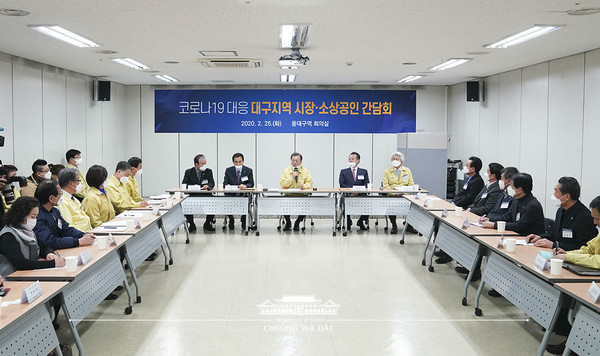Eying to inject $25 billion into virus control
By Publisher Lee Kyung-sik with Chung Won-sik
President Moon Jae-in of the Republic of Korea on March 3, 2020 declared a ‘war against COVID-19’ as the crisis in the Daegu City in the central and nearby Gyeongsangbuk-do Province made a steep rise, placing all government agencies on a 24-hour full alert.
Speaking at a weekly Cabinet meeting on that day President Moon announced plans to inject 30 trillion won (US$25 billion) of funds directly or indirectly into the virus response. The meeting was held in combination with a daily session of the Central Disaster and Safety Countermeasure Headquarters at the central government office complex in Seoul.

Moon stated that the continuing confirmation of additional cases is "a critical phase" and added that the situation has changed completely due to the massive number of infections of the followers of the Shincheonji religious group.
President Moon’s remarks came as health authorities put the total number of people infected with the virus across the country at 5,186, which represented an increase of 600 cases from the preceding day. Most of the cases were reported in the Daegu City some 300 kilometers southeast of Seoul, and the neighboring province.
"The crisis in Daegu and Gyeongsangbuk-do Province reached its peak and the whole country has started a war against the infectious disease," Moon said.
He ordered all the government organizations to shift to a "24-hour emergency situation room system," citing the need to bolster readiness to handle quarantine and economy-related measures.
"The economic situation is grave," Moon said adding that the government would spend 30 trillion won in dealing with the crisis, including a planned supplementary budget.
He also apologized deeply to the nation for the failure to supply masks quickly and sufficiently. He called on the government to take strong steps to address the problem.
According to Chosun Ilbo, a Korean-language daily newspaper, which is known to have the largest circulation in Korea, said on March 2 that the
coronavirus epidemic is getting more serious by the day. The total number of confirmed infections in Korea surpassed 1,000 on Feb. 26 and reached 3,700 just four days later.
Then it said that a 10,000-mark loomed large on the horizon as many more followers of the Shincheonju Chruch remain untested. Health officials contacted by telephone 200,000 out of 300,000 sect followers and 3,900 apparently admitted that they had tell-tale symptoms. That meant that many more confirmed cases could be reported among them. The high rate of infection, according to the Chosun report, was demonstrated in one instance when a woman without a face mask who briefly rode the same elevator with a confirmed carrier ended up infected. There are probably many more carriers without symptoms scattered throughout the country and so the number of confirmed cases could soar to tens of thousands, it estimated.
In Daegu, 65% of the 2,569 confirmed cases remain in self-quarantine at home due to shortage of hospital beds. One 75-year-old carrier who had received a kidney transplant died at home. Fears increased in the Daegu City as it might be subject to a Wuhan-style lockdown. There were 830 confirmed cases in Wuhan when the city was locked down on Jan. 23, and the number soared to 7,830 on Jan. 30, 28,100 on Feb. 6 and to 63,900 on Feb. 14. One quarantine expert in Korea said, "I'm afraid March is going to be a nightmare."
Chosun feaed that there were increasing signs that Korea's medical resources were stretched to the limit. Suspected carriers in the Daegu City, who have grown tired of the long waiting lines, were traveling to the Busan City to get tested at an early time. Medical personnel were increasingly tired and so were the nurses.
According to a report by The Korea Herald, a leading English national daily in Korea said on March 3 that the number of COVID-19 cases in the country has surged to 4,812, with 28 deaths reported so far, as the government struggled to prevent further fatalities amid hospital overcrowding.
Korea reported 600 more cases and six additional deaths as of midnight on March 2 according to the Korea Centers for Disease Control and Prevention.
Of the new cases, 519 were confirmed in Daegu (86.5 percent), 61 in North Gyeongsang Province (10 percent), 7 in Seoul 1.6 percent), 3 in South Chungcheong Province (0.5 percent), 2 each in Busan, Gwangju and Gyeonggi Province (0.3 percent).
Of the country’s total, 3,600 were concentrated in the Daegu City region and 685 in the Gyeongsangbuk-do Province, accounting for 89 percent of the total.
A total of 29 people died from the coronavirus, with most cases being in their 50s and 80s with preexisting illnesses. The fatality rate stands at 0.6 percent for all age groups, 4 percent for those in their 70s and 5.4 percent for those aged 80 or over.
Some 34 patients have so far released from quarantine after making full recoveries.
The number of coronavirus cases is expected to soar in the coming days with testing of more than 210,000 members of the Shincheonji Church of Jesus—Korea’s biggest cluster of infections--still underway.
“COVID-19 brought the Korean economy into a state of complete suspension,” griped a Korean businessman. The actual market conditions felt reminds the people of the devastating foreign exchange and financial crises.
Not only the small businesses but also some of the big ones have started laying off employees, some of them cutting down the wages of their employees. Some even predict that the economic growth rate for this year would be zero.
Against this drop, it has become necessary for the government to prepare additional budgetary plans.

